![How One eCommerce Store Tripled Traffic In 3 Months With Content Marketing [Case Study] How One eCommerce Store Tripled Traffic In 3 Months With Content Marketing [Case Study]](https://bloggersidekick.com/wp-content/uploads/2017/01/How-One-eCommerce-Store-Tripled-Traffic-In-3-Months-With-Content-Marketing-Case-Study-270x141.jpg)

Do you run an eCommerce store or plan to launch one in 2017? What would it be worth to you if you could 3x your traffic in a short period of time?
In this article I will share a short-term traffic case study from one of our eCommerce clients. They managed to triple their traffic in just three months all with the power of effective content marketing.
The reason I’m sharing the tactics and results of this case study are because I know that eCommerce stores have unique traffic needs.
Every online business “wants” more traffic, but for an eCommerce store it’s literally your lifeblood.
Without traffic you can’t sell products, and without selling products you can’t grow and flourish as a business.
But where do most eCommerce stores go for traffic? Usually they go straight to the traffic store – Google AdWords.
The problem with an AdWords-only strategy
AdWords makes a lot of sense for eCommerce stores. You capture the attention of potential customers right at the bottom of the funnel as they are specifically looking for a product or solution to their problem.
Not only that, but with Google Shopping you can feature your exact products with a nice looking call-to-action and visual image right in front of those prospects.

The Google AdWords system also provides a very easy to understand cost-in, revenue-out reporting system. If you setup analytics properly and track your site activity, it becomes easy to see a direct ROI from your spend.
But there’s a couple of problems with relying on AdWords alone…
One, when you stop paying for those ads your revenue essentially grinds to a halt. That means your profit margins are always going to be reliant on an algorithm designed to take your money. As competition continues to grow in this space, and Google continues to chase more revenue from ads, your cost per acquisition will grow as well.
Two, an AdWords-only strategy is targeted towards price shoppers.
What makes someone click on YOUR ad in that search result?
There are three primary factors that influence a consumers behavior in this situation:
- They click based on position. The top left result usually performs the best, but you pay a premium for that slot.
- They click based on price. So if you want to offer the lowest price (lowest margin) product, then you can compete for these clicks.
- They click based on credibility and trust. If you have a high level of trust associated with your brand, you can get away with a higher price and a worse position in the search.
So what is proven to build brand credibility and trust more than any other marketing strategy? Content marketing.
I’m not saying to throw your AdWords strategy out with the bath water, but instead to combine it with effective content marketing and brand-building.
In the short term this approach has the potential to lower your ad spend. And in the long term, your whole business will become less reliant on AdWords… Which means at some stage in the future you could simply switch off the ads and it wouldn’t be crippling to your business.
The mental battle between short-term income and long-term prosperity
Every business owner says that they’re in it for the long haul, but often their actions tell us something quite different.
The long-term mindset is focused on brand building, authority and embedded trust with your customer group. The short-term mindset is obsessed over the daily, weekly and monthly revenue metrics.
I’m not here to place judgement… I completely understand both sides of that equation. After all, you need to pay the bills.
But the reason I bring it up is because most people give up too early.
Content marketing is hard work, especially during those first few months. It’s very easy to look at your AdWords metrics, compare them to your blog traffic, and make a short-term decision about where to invest your money.
It’s much harder to stick to your guns, stay on track with the strategy you have laid down and believe that it will work out in the long run.
Because history tells us it will. Content marketing works, but it only works for those willing to stick it out and keep turning up.
In the eCommerce case study I’m about to share with you we faced this exact problem.
The CEO wanted better search engine rankings and authority in the market. They were dedicated to content marketing and willing to give it a go. But deep down they were attached to these short-term outcomes. They wanted results much sooner than what was traditionally achievable through these channels.
So we had to find a way to deliver on both counts. Better search engine rankings and authority in the long-term, BUT a significant lift in traffic and engagement in the short term.
Here’s what happened…
A short background
For the purpose of confidentiality I can’t reveal the name of the brand in this case study, but here’s a brief overview of who they are and what they do…
This eCommerce business has been operating for a couple of years now, and they predominantly serve the Australian and New Zealand travel market.
Their lightweight luggage, packing accessories and travel safety equipment are quickly gaining a reputation for being the highest quality in the market. So this gave us something to work with.
Up until October 2016 they were relying heavily on AdWords traffic to produce sales. Despite publishing a few sporadic blog posts and setting up social accounts on Facebook and Instagram, content marketing was essentially non-existent in their growth strategy.
The CEO had been reading about content marketing for a while, and was excited to give it a try. But time and resources had held them back.
That’s when they came to us…
The results
The first thing we do with any new client is to audit their current marketing workflow, email setup and content marketing activity. Once we understand the starting point from a strategic point of view, then we lay the foundation with a re-vamped strategy for the first 6 months of work together. I’ll share what that looked like in this example in a moment.
But before we jump into the strategy, let’s take a quick look at the state of play from a traffic perspective.
In September 2016 this website’s monthly sessions were 6,549, with pageviews of 26,975:
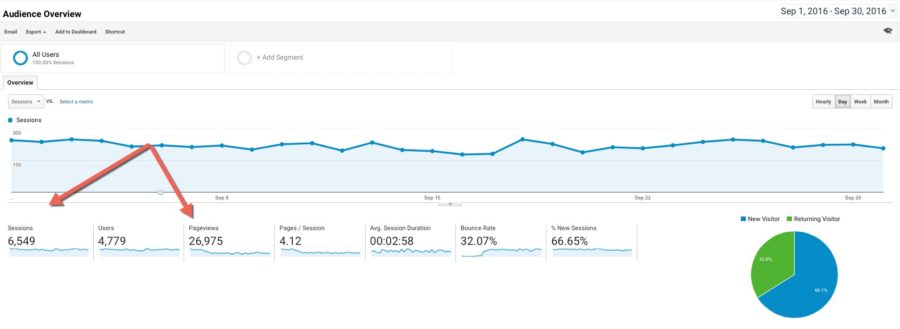
The breakdown of this traffic is also important to note, with over half of it coming from Paid Search or Display Ads:
We published the first blog post article under the new content marketing strategy towards the end of October, which as a month saw very similar traffic stats to September.
This is what happened in the two months to follow.
Monthly sessions skyrocketed to 13,069 and 36,189 pageviews in November:
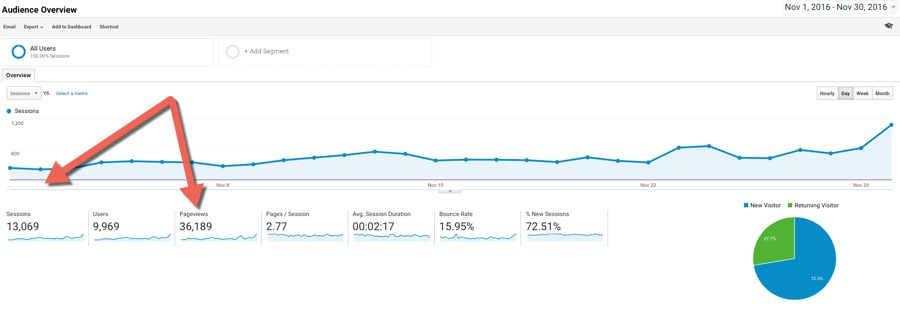
As you can see by the traffic source breakdown, the Paid Search and Display traffic remained fairly constant from September to November, with Social traffic now the primary source:
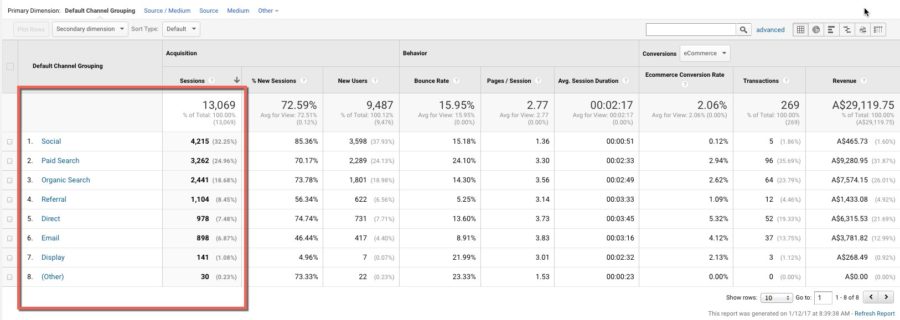
December once again saw a rise in traffic, this time to 18,088 sessions and 45,101 pageviews:

The coolest thing about these December numbers is that Paid Search traffic actually significantly decreased compared to previous months:

You may have already noticed on the right-hand side of these analytics that the revenue numbers also grew from around 17K in September to 29K and 27K in November and December respectively. But it’s important to understand that there is an element of seasonality with this jump, given November/December is typically the highest revenue period for any eCommerce business because of Christmas sales.
However, what is interesting to note is that the ratio between Paid Search and Revenue (Dollars made per unit of paid search traffic), has steadily risen from 5.87 in September, to 8.92 in November and 11.54 in December.
So do you want to find out how we got these results?
Let’s unpack the strategy…
The eCommerce content marketing strategy that tripled traffic in 3 months
Step 1 – Goals & Metrics
The first step to mapping out any effective content strategy is always to define the goals.
If you don’t know where you want to go, you won’t know how to get there, and you certainly won’t know how to measure it.
The data you gather and the metrics you track then become a quantifiable way to move towards these pre-set goals over time.
The primary goal for this eCommerce business was defined as: “Increase brand authority and grow customer base”.
Ok so that’s a great starting point, but it’s not measurable enough. So what would it look like to have more brand authority? How many more customers do you actually want to get to make this worthwhile?
After defining a broader goal, you need to outline the key metrics to track progression toward that goal and identify mini-goals for each of them. Here are some examples stemming from that above primary goal:
- Double monthly traffic in 6 months without further AdWords investment (Exceeded in 3 months)
- Increase social shares from 0 to 50+ per post (Average per post is well over 100 now)
- Get a 10% increase in checkout goals (On track, but too early to tell because of seasonality)
We track all of these things, and more, in a Google sheet. Some of the metrics are blurred out for confidentiality:
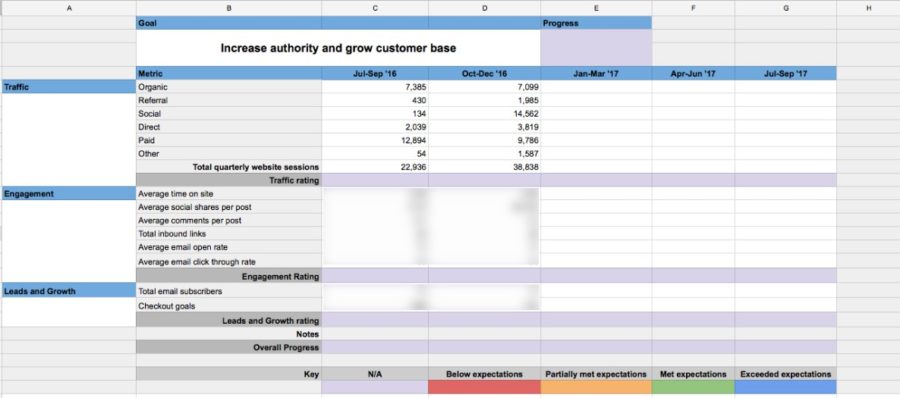
Step 2 – Research
Before jumping into the heart of the strategy, research is an essential component to making it all work effectively. Otherwise it’s just guesswork.
At this stage you are looking for more information about your ideal audience, your competitors, keywords that you can eventually rank for, and influencers in your market.
This research guides your content planning, editorial schedule and promotion plan moving forward.
Here is a brief overview of how we gathered the key information for this step in the process:
- Primary Data. The client answered a 20-question survey about their customers, value proposition and competitive landscape. These verbatim comments were the fuel for further secondary research. The questions in the survey range from “Where do your ideal customers live”, all the way through to “If you were to be known for only 3-5 topics, what would they be?” – every question has a purpose and is designed to give us the specific information we need to go deeper into the research process, without burdening the client with too many questions.
- Secondary Data. Once we have these survey responses, it’s time to dive into the keyword and competitor research in more depth. At this stage we are looking for “content opportunities”. Content opportunities are when a topic, or search term has; good search volume, underdone or outdated content that you can improve on, and the available content has a good level of engagement such as links and social shares. To find this information we use tools such as BuzzSumo, ahrefs and Google AdWords Keyword Planner.
The end output of this research process is a long list of potential search terms, that are essentially blog topics, along with their search volume and ranking difficulty.
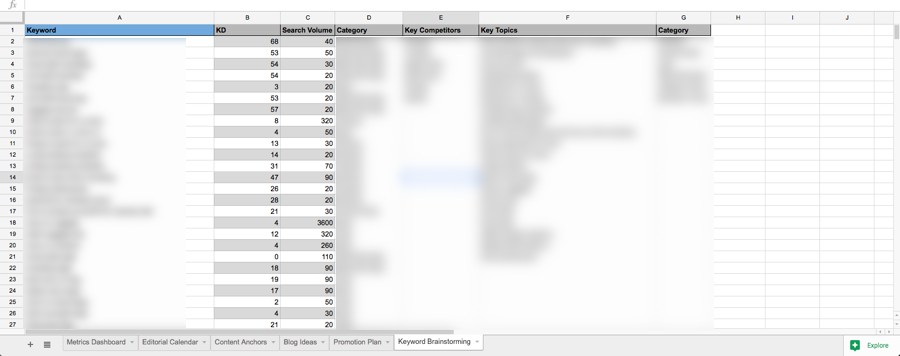
Step 3 – Content Planning
That long list of keywords is not very helpful to anyone at this stage, it needs to be repurposed into something more meaningful.
The two things we are looking to develop during the content planning step are an “Editorial Calendar” and the “Content Anchor” topics. (If you’re not familiar with what a content anchor is, read this post)
Your content anchors will act as pillars to the rest of your strategy. They are the cornerstones and definitive resources for each primary blog category, and guide the direction of the rest of your blog content.
The content anchors should tick all of these boxes:
- They are a topic the business wants to be “known” for
- They are closely related to a core problem of your ideal customer, that your products can solve
- They offer one of the better “content opportunities” in terms of search volume, ranking potential and shareability
Once you have landed on a set of content anchors (in this case study we went for four topics) you can then structure the rest of the editorial calendar based on the desired activity.
It will look a little something like this:
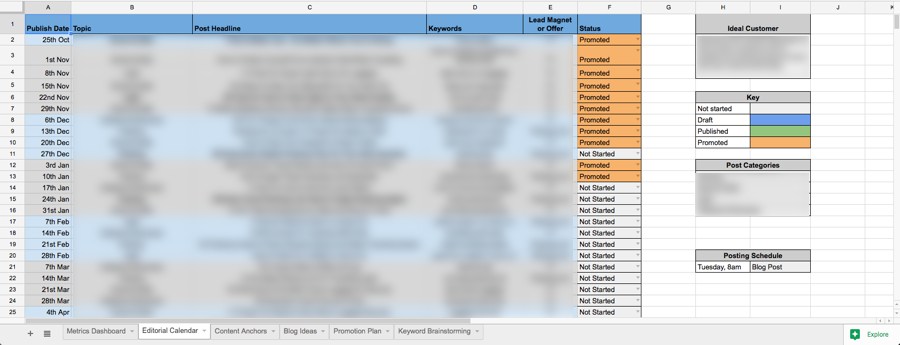
For this eCommerce store we decided to publish one blog post a week, but that’s not necessarily the ideal rhythm for every business. It will depend on your resources, appetite for speed and ability to maintain consistency.
Step 4 – Planning for Execution
With the editorial schedule planned out for over six months, energy shifts to figuring out how to resource the execution of that content plan.
The important elements to consider at this stage are:
- How will you create the blog content required for this plan? Will it be with internal contributors or outsourced writers? Or will it be a combination?
- How will you promote the blog content? Who will be accountable to do this every time a post goes live?
The CEO of this eCommerce store was short on time, and had a long list of other high-priority activities to focus on. Plus they only had a small team. So they were happy to fully outsource this process to us, which in my experience is the most effective way to deliver fast results. (Letting someone own it, either fully in-house or completely outsourced)
The ongoing workflow looked a little something like this:
- Develop a blog post structure and get confirmation from the internal champion
- Create the content with expert writers, including a unique feature image and other visuals throughout the article
- Edit and publish the content on the website, with final approval from the internal champion
- Optimize the content for SEO with relevant internal linking, keyword optimization and a compelling meta description
- Schedule social media shares in the week following publication – Facebook and Instagram
- Conduct social media outreach to a minimum of 50 influencers that have shared similar content in the past
- Draft and schedule an email broadcast promoting the blog post to their email database
- Share the blog content with online communities such as Scoop.it, CoPromote, Viral Content Bee and Quuu
- Run a Facebook ads campaign that is optimized for “Clicks to Website” – average spend $60-80 per blog post.
In the background
To make this content strategy effective, there needed to be a number of things going on “in the background”, beyond just the regular posting of content to the blog.
These additional activities included the following (some were done in-house):
- Proactive link building for SEO – using guest blogging and email outreach (For more eCommerce SEO tips see this guide)
- Lead magnet creation – to entice more email opt-ins from the increased website traffic
- Tailored email automation sequences – based on the lead magnets and optimized for eventual product purchases
- Remarketing campaigns – to encourage lead magnet opt-ins for those that didn’t take the bait on first visit
- Social media follower growth and user engagement – on Instagram and Facebook pages
Wrapping it up
The results from this eCommerce content marketing case study are certainly above average, but they are definitely achievable.
You just need the right strategy, guidance and some dedicated execution.
The most important thing is turning up. Week after week, continuing to be present and adding value to your ideal customers.
Is content marketing making a difference to your eCommerce business? Or are you missing out?
